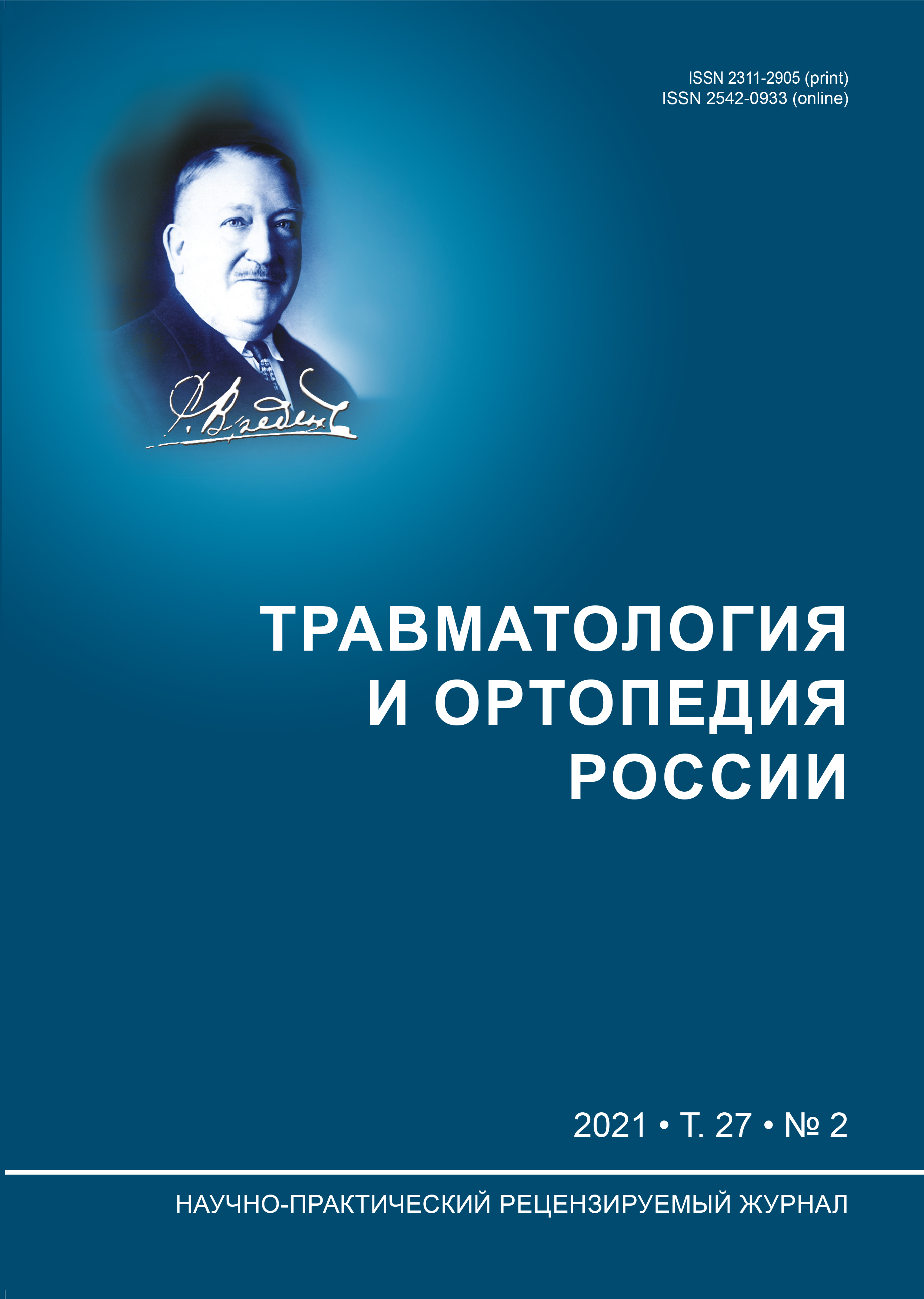Маршрутизация и лечение больных гематогенным остеомиелитом позвоночника на примере юга Тюменской области
- Авторы: Базаров А.Ю.1
-
Учреждения:
- ГБУЗ ТО Областная клиническая больница №2 г. Тюмень
- Выпуск: Том 27, № 2 (2021)
- Страницы: 124-131
- Раздел: Организация травматолого-ортопедической помощи
- Дата подачи: 30.08.2020
- Дата принятия к публикации: 03.05.2021
- Дата публикации: 05.05.2021
- URL: https://journal.rniito.org/jour/article/view/1512
- DOI: https://doi.org/10.21823/2311-2905-2021-27-2-124-131
- ID: 1512
Цитировать
Полный текст
Аннотация
Актуальность: в настоящее время предложены различные варианты алгоритмирования, тактических классификаций и схем лечения гематогенного остеомиелита позвоночника. Однако, все предложенные подходы рассчитаны на лечение пациентов в специализированных отделениях многопрофильных клиник, хотя первичное обращение нередко происходит в муниципальные поликлиники, частные медицинские центры и стационары уровня центральной районной больницы. Вопрос о том, каков целесообразный объём лечебных и диагностических мероприятий в учреждениях с различной материально-ресурсной базой и как обеспечить преемственность согласно имеющейся трёхуровневой системы оказания медицинской помощи остаётся открытым.
Цель: определить вероятную маршрутизацию и возможности лечения больных гематогенным остеомиелитом позвоночника на примере юга Тюменской области в зависимости от имеющейся трёхуровневой системы оказания медицинской помощи населению.
Материалы и методы: проанализированы действующие Приказы Минздрава России и Постановления правительства Тюменской области, на основании которых организована трёхуровневая система оказания медицинской помощи населению и определены организации, оказывающие экстренную и плановую медицинскую помощь пациентам с гематогенным остеомиелитом позвоночника.
Предложены перечень обязательных исследований и объём лечебных мероприятий у больных остеомиелитом позвоночника в учреждениях различного уровня, а также их маршрутизация при невозможности оказания специализированной медицинской помощи на примере юга Тюменской области.
Результаты: определён перечень медицинских учреждений, оказывающих экстренную и плановую помощь по травматологии и ортопедии, нейрохирургии на территории юга Тюменской области в зависимости от уровня учреждения и имеющейся материально-ресурсной базы. Предложена блок-схема определяющая объём лечебно-диагностических мероприятий в учреждениях I-III уровней и специализированных отделениях многопрофильных клинических больниц. Предложен принцип определения профиля пациента (хирургический, ортопедический, нейрохирургический) в зависимости от типа и тяжести воспалительного поражения согласно русскоязычной версии классификации E. Pola 2017 г.
Заключение: необходимо эффективное использование лечебно-диагностических ресурсов начиная с I (базового) уровня и предельно подробное информационное сопровождение пациента для обеспечения преемственности оказания медицинской помощи. Полноценная диагностика возможна в учреждениях не ниже третьего уровня с обязательным определением типа поражения и тяжести воспалительного процесса. Лечение ГОП целесообразно в учреждениях III уровня, специализированных отделениях областных клинических больниц, университетских клиник и федеральных учреждений.
Определение профиля пациента: при поражениях типа А.1-А.5, В.1, а также В.2 с протяжённостью паравертебральных абсцессов до 2,5-3 см – лечение в хирургических отделениях многопрофильных стационаров.
В.2-В.4 – лечение в профильных травматолого-ортопедических отделениях и отделениях гнойной остеологии при наличии в штате хирурга-вертебролога.
С.1-С.4 – лечение в профильных нейрохирургических отделениях с участием хирурга-вертебролога.
Ключевые слова
Об авторах
А. Ю. Базаров
ГБУЗ ТО Областная клиническая больница №2 г. Тюмень
Автор, ответственный за переписку.
Email: tyumen_trauma@mail.ru
ORCID iD: 0000-0002-5309-4667
Базаров Александр Юрьевич — канд. мед. наук,
заведующий операционным блоком
г. Тюмень
РоссияСписок литературы
- Мушкин А.Ю., Вишневский А.А., Перецманас Е.О., Базаров А.Ю., Басанкин И.В. Инфекционные поражения позвоночника: проект национальных клинических рекомендаций // Хирургия позвоночника. 2019. Т. 16. No 4. С. 63–76. DOI: http://dx.doi.org/10.14531/ss2019.4.63-76.
- Taylor DG, Buchholz AL, Sure DR, Buell TJ, Nguyen JH, Chen CJ, Diamond JM, Washburn PA, Harrop J, Shaffrey CI, Smith JS. Presentation and outcomes after medical and surgical treatment versus medical treatment alone of spontaneous infec- tious spondylodiscitis: a systematic literature review and meta-analysis. Global Spine J. 2018;8(4 Suppl):49S–58S. doi: 10.1177/2192568218799058.
- Pola E, Autore G, Formica VM, Pambianco V, Colangelo D, Cauda R, Fantoni M. New classification for the treatment of pyogenic spondylodiscitis: validation study on a population of 250 patients with a follow-up of 2 years. Eur Spine J. 2017;26(Sup- pl 4):479–488. doi: 10.1007/s00586-017-5043-5.
- Bhavan KP, Marschall J, Olsen MA, Fraser VJ, Wright NM, Warren DK. The epidemiology of hematogenus vertebral osteomyelitis: a cohort study in a tertiary care hospital. BMC Infect Dis. 2010;10:158. doi: 10.1186/1471-2334-10-158.
- Berbari EF, Kanj SS, Kowalski TJ, Darouiche RO, Widmer AF, Schmitt SK, Hendershot EF, Holtom PD, Huddleston PM, Petermann GW. Executive Sum- mary: 2015 Infectious Diseases Society of America (IDSA) Clinical Practice Guidelines for the Diagnosis and Treatment of Native Vertebral Osteomyelitis in Adults. Clin Infect Dis. 2015;61:859–863. doi: 10.1093/cid/civ633.
- Duarte RM, Vaccaro AR. Spinal infection: state of the art and management algorithm. Eur Spine J. 2013;22:2787–2799. doi: 10.1007/s00586-013-2850-1.
- Fantoni M et al (2012) Epidemiological and clinical features of pyogenic spondylodiscitis. Eur Rev Med Pharmacol Sci 16(Suppl 2):2–7
- Homagk l, Homagk N, Klauss JR, Roehl K, Hofmann GО, Marmelstein D. Spondylodiscitis severity code: scoring system for the classification and treatment of non-specific spondylodiscitis. Eur Spine J. 2016;5:1012–1020. DOI: 10.1007/ s00586-015-3936-8.
- Мушкин М.А., Дулаев А.К., Абуков Д.Н., Мушкин А.Ю. Возможно ли тактическое алгоритмирование при инфекционном поражении позвоночника? Обзор литературы // Хирургия позвоночника. 2020. Т. 17. No 2. С. 64–72. DOI: http://dx.doi.org/10.14531/ss2020.2.64-72.
- Базаров А.Ю. Классификации неспецифического гематогенного остеомиелита позвоночника. Критический анализ и предложения по применению // Травматология и ортопедия России. 2019. Т. 25. No 1. С. 146–155. doi: 10.21823/2311-2905-2019-25-1-146-155.
- Homagk l, Homagk N, Meise HJ, Hofmann GO, Marmelstein D. А spondy- lodiscitis scoring system: SponDT – spondylodiscitis diagnosis and treatment. JSM Spine. 2016;1(1):1004. [Electronic resource]. URL: https://jscimed- central.com/Spine/ spine-1-1004.pdf.
- Jeong DK, Lee HW, Kwon YM. Clinical value of procalcitonin in patients with spinal infection. J Korean Neurosurg Soc. 2015;58:271–275. doi: 10.3340/jkns.2015.58.3.271.
Дополнительные файлы







